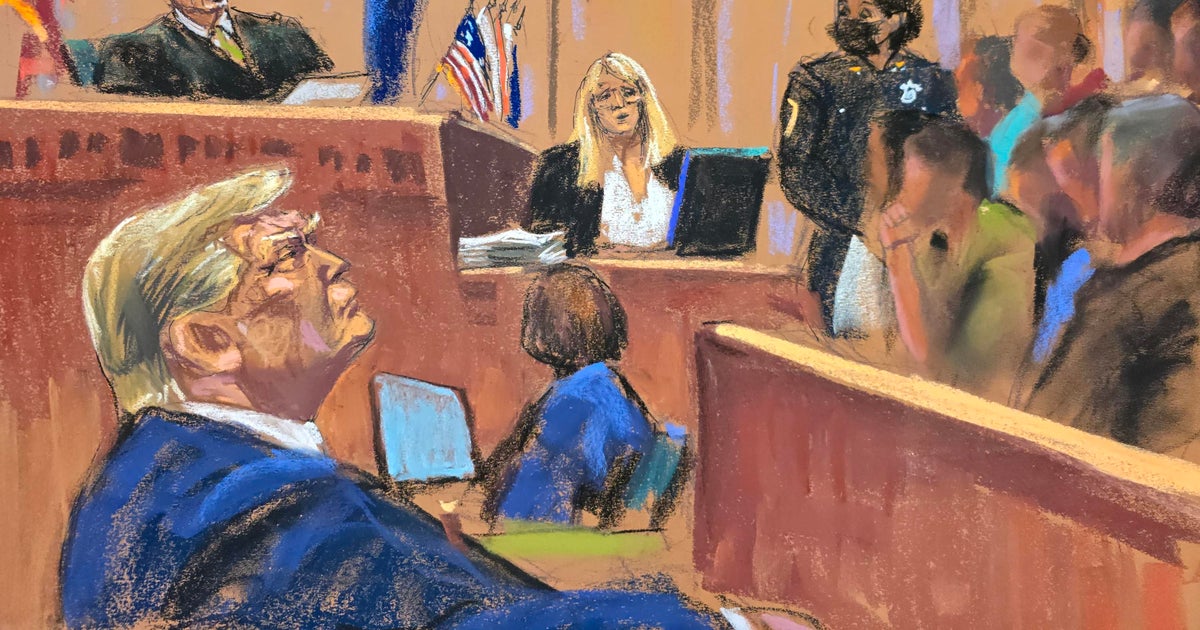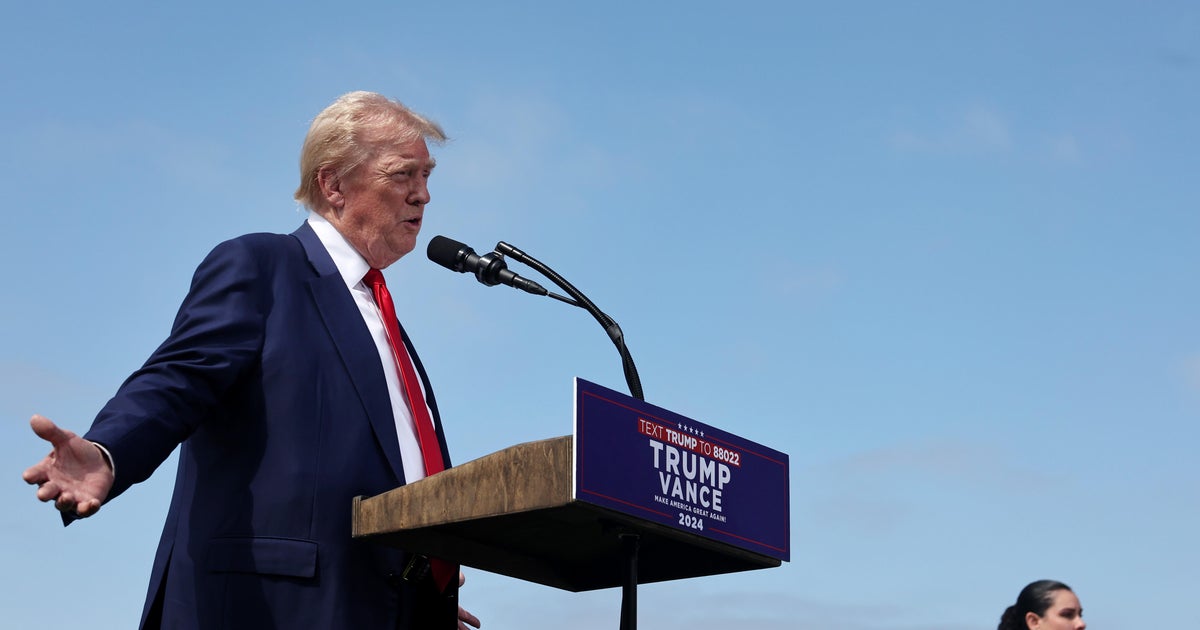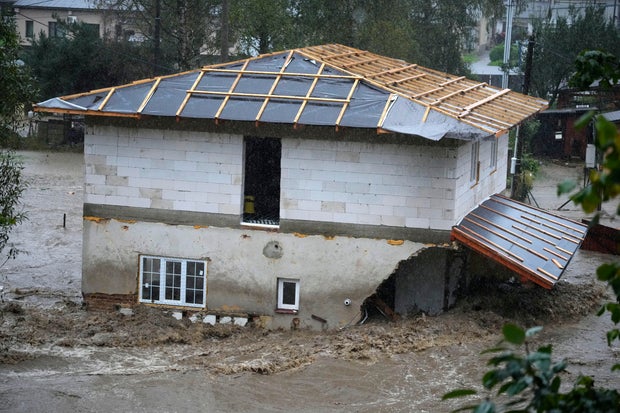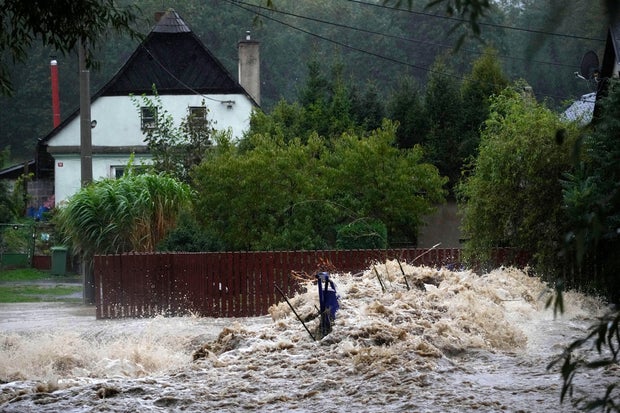CBS News
The muted frenzy in the courtroom when Donald Trump was convicted of felonies in New York

Just before 4:15 Thursday afternoon, Donald Trump’s voice could be heard, muffled, from beyond the thick doors of Manhattan Criminal Court’s room 1530.
“I want to campaign,” Trump said to the TV cameras positioned in the hallway.
He and his entourage entered the courtroom and took their places at the defense table and in two rows of gallery benches behind.
Prosecutors had already filed in. A few minutes later, Justice Juan Merchan arrived.
Merchan said he brought the two sides to the room because he intended to excuse the jury at 4:30 p.m., the usual close of business in Manhattan Criminal Court. He wanted everyone present to end the proceedings.
“We’ll give them a few more minutes, and then we’ll excuse them,” Merchan said.
Merchan then left for his robing room, saying he’d return shortly.
When a jury that’s heard a trial in room 1530 is deliberating, the outside world is typically informed that the jurors have a question, a note, or a verdict, when an antiquated bell rings.The court officer-enforced silence of the courtroom is suddenly jolted by the noise, like an apartment door buzzer coupled with a tinny bell.
That noise rang out twice Wednesday afternoon, when the jurors requested a read-back of testimony and the judge’s instructions.
Thursday began with the judge re-reading his part of their request. Two court reporters then performed the transcripts for the jury – one in a flat monotone and thick New York accent, the other animatedly reading her lines — playing the parts of David Pecker and Michael Cohen, among others. Then the jury of seven men and five women went back to deliberate.
The rest of the day was filled with radio silence. No bells, no notes.
But they were working, deliberating, reaching a consensus.
It appears that when the jury was told they’d soon be excused, they said they weren’t quite ready to go.
As 4:30 came and went back in the courtroom, the lawyers in the well and the defendant stirred with casual annoyance.
Where’s the judge? And how about the jury?
The defendant had a tight schedule. He’s not only a former president, but the presumptive Republican nominee for president again. His communications director Steven Cheung and other aides were in the second row of the gallery. His son Eric sat in the first row, next to Alina Habba, a spokesperson for the Trump legal effort.
At 4:36, the judge came in.
“I apologize for the delay,” Merchan said. “We received a note. It was signed by the jury foreperson at 4:20. It’s marked as Court Exhibit Number 7.”
The note included an announcement, followed by a very polite request:
‘We, the jury, have a verdict. We would like an extra 30 minutes to fill out the forms. Will that be possible?”
Imagine the sound of dozens of people losing, and quickly catching, their breaths.
Courtroom decorum demands quiet. So a muted frenzy ensued.
Prosecutors whispered, Trump’s team rustled and tapped away on phones. Dozens of reporters’ keyboards clattered. Some grumbled about the room’s poor wi-fi. Courtroom officers admonished the grumblers.
Trump’s demeanor shifted.
He had seemed jovial, chatting with attorney Todd Blanche before news of the verdict. After the announcement, he sat as he had through much of the trial, motionless, a little slumped in his seat, facing straight ahead.
Manhattan District Attorney Alvin Bragg, who attended the trial only intermittently, arrived to watch the outcome of perhaps the most scrutinized, and historic, case he’ll ever lead.
Every seat in the courtroom was taken, it was standing room only, and the only people standing were court officers. They paced the aisle and perimeter, keeping the restive silence and patrolling for cellphones, a quiet courtroom’s truest enemy.
The minutes pass by slowly, hushed, as one of the world’s most powerful people awaited his fate.
Just after 5 p.m. Merchan returned. He reread the jury’s note into the record.
“Are we ready to bring out the jury?” Merchan asked
“Yes, Judge,” said prosecutor Joshua Steinglass, who exactly two days earlier at 5 p.m. was merely halfway through a marathon closing argument that kept the courtroom open well into the evening.
“Yes,” Trump attorney Todd Blanche said.
“Bring out the jury, please,” Merchan said.
5:04 p.m.: Through a side door, six alternate jurors walked in and were given front row seats in the gallery. They attended the trial dutifully for weeks, taking notes so copious Merchan complimented them on how seriously they took their jobs, knowing they might not get to weigh in on the final decision.
5:05 p.m.: “All rise,” a court officer bellowed. Trump stood, his arms at his sides.
None of the jurors looked at Trump as they filed past; many had their eyes to the ground. Throughout the trial, as jurors came and went, he stared at them, but they rarely met his gaze. This time he focused straight ahead.
Everyone sat and Merchan recounted the note one more time.
In New York, the first juror seated is automatically the foreperson. He sat silently for weeks, but his moment was approaching. The eyes of the court, and the attention of the world, were about to turn to him.
“Mr. Foreperson,” Merchan said, his voice seeming to waver slightly, “without telling me the verdict, has the jury, in fact, reached a verdict?”
“Yes, they have,” he said.
Eric Trump could be seen briefly shaking his head.
“Take the verdict, please,” Merchan said to the court’s clerk, who asked the foreperson to rise.
He stood, leaning his left arm on a banister as his right hand held a microphone.
“How say you to the first count of the indictment, charging Donald J. Trump with the crime of falsifying business records in the first degree, guilty or not guilty?” the clerk asked.
“Guilty.”
“How say you to count two?”
“Guilty.”
“How say you to count three?”
Guilty.
Trump’s eyes appeared to close, and his head shook slightly, lips pursed and eyes downcast.
Each count corresponds with a different check, invoice or voucher falsified at Trump’s behest, to cover up a conspiracy to influence the 2016 election through unlawful means. So after the third count, it was hard to image any of the remaining 31 being “not guilty.” Still, he had to sit and listen.
“How say you to count four?”
“Guilty.”
“How say you to count five?”
“Guilty.”
“How say you to count six?”
“Guilty.”
“How say you to count seven?”
“Guilty.”
“How say you to count eight?”
“Guilty.”
“How say you to count nine?”
“Guilty.”
“How say you to count 10?”
“Guilty.”
As the foreman read, a number of the jurors kept their eyes down.
“How say you to count 11?”
“Guilty.”
“How say you to count 12?”
“Guilty.”
“How say you to count 13?”
“Guilty.”
“How say you to count 14?”
“Guilty.”
“How say you to count 15?”
“Guilty.”
“How say you to count 16?”
“Guilty.”
“How say you to count 17?”
“Guilty.”
“How say you to count 18?”
“Guilty.”
“How say you to count 19?”
“Guilty.”
“How say you to count 20?”
“Guilty.”
“How say you to count 21?”
“Guilty.”
“How say you to count 22?”
“Guilty.”
“How say you to count 23?”
“Guilty.”
“How say you to count 24?”
“Guilty.”
“How say you to count 25?”
“Guilty.”
“How say you to count 26?”
“Guilty.”
“How say you to count 27?”
“Guilty.”
“How say you to count 28?”
“Guilty.”
“How say you to count 29?”
“Guilty.”
“How say you to count 30?”
“Guilty.”
“How say you to count 31?”
“Guilty.”
“How say you to count 32?”
“Guilty.”
“How say you to count 33?”
“Guilty.”
“How say you to count 34? “
“Guilty.”
One of the key moments in the defense’s case revolved around questioning how much information witness Michael Cohen could have conveyed in a one-and-a-half-minute phone call. Could Cohen have told Trump’s bodyguard about a teenager who had been prank calling him, and then updated negotiations to buy an adult film star’s silence about an alleged sexual encounter?
The defense said, no way. A prosecutor went so far as to demonstrate during closing arguments a hypothetical phone call where that information is conveyed in under a minute.
It’s 5:08 p.m. The jurors had entered, walked past Trump, the judge, Bragg and others, crossing the court and sitting in their assigned seats. The foreperson had addressed the judge, and done a 34-count call and repeat.
All in just three minutes.
They had convicted Donald John Trump. The 45th President of the United States was now a felon.
His body remained motionless, but the corners of his lips sank.
Blanche asked for the jurors to be polled. Each confirmed they agreed with the verdict.
Merchan thanked the jurors, recounting that the trial began with jury selection on April 15.
“That’s a long time. That’s a long time you were away from your jobs, your families, your other responsibilities. But, not only that, you were engaged in a very stressful and difficult task,” Merchan said.
“I want you to know that I really admire your dedication and your hard work. I observed you. As I said before, I observed you during the course of the trial, and I could see how involved you were, how engaged you were, how invested you were in this process. And you gave this matter the attention it deserved. I want to thank you for that.”
Lawyers on the prosecutors’ side of the room nodded in agreement. Trump seemed still to barely move.
All rose again as the jurors were excused. Again, none looked at Trump, and Trump looked at none.
Blanche immediately asked Merchan to set aside the verdict and enter a judgment of acquittal. The motion was denied.
The judge set a sentencing hearing for July 11. He then left.
Trump and his entourage stood to leave, his lips a parabola meeting the sides of his chin. He took a few steps, gently grasped his son’s hand for a moment. He turned and slowly walked toward the room’s back doors.
As he exited the courtroom, he walked heavily, a deep frown on his flushed face.
The trial was over. The prosecutors were packing their briefcases and bags.
From within the courtroom, the muffled but familiar voice of a perennial presidential candidate could be heard, back on the trail, decrying his treatment.
CBS News
At least 8 dead, 4 missing as torrential rain and flooding hits Central Europe

The death toll was rising in Central European countries on Sunday after days of heavy rain caused widespread flooding and forced mass evacuations.
Several Central European nations have already been hit by severe flooding, including Austria, the Czech Republic, Poland and Romania. Slovakia and Hungary might come next as a result of a low pressure system from northern Italy dumping record rainfall in the region since Thursday.
Six people have died in the floods in Romania. In Austria, a firefighter died during a flood rescue, and, in Poland, one person died from drowning, the BBC reported. In the Czech Republic, police said four people were still missing after being swept away by floodwaters.
Officials declared the Austrian province that includes Vienna a disaster area, calling the weather “an unprecedented extreme situation,” while Polish Prime Minister Donald Tusk urged residents to cooperate with rescue teams in an announcement Sunday confirming the death in that country, according to the BBC.
Most parts of the Czech Republic have been affected as authorities declared the highest flood warnings at around 100 places across the country. But the situation was worst in two northeastern regions that recorded the biggest rainfall in recent days, including the Jeseniky mountains near the Polish border.
Petr David Josek / AP
In the city of Opava, up to 10,000 people out of a population of around 56,000 have been asked to leave their homes for higher ground. Rescuers used boats to transport people to safety in a neighborhood flooded by the raging Opava River.
“There’s no reason to wait,” Mayor Tomáš Navrátil told Czech public radio. He said that the situation was worse than during the last devastating floods in 1997, known as the “flood of the century.”
“We have to focus on saving lives,” Prime Minister Petr Fiala told Czech public television on Sunday. His government was set to meet Monday to assess the damages.
The worst “is not behind us yet,” the prime minister warned as the flooding made its way through the country.
President Petr Pavel sounded more optimistic, saying “it’s obvious we’ve learned a lesson from the previous crisis.”
Thousands of others also were evacuated in the towns of Krnov, which was almost completely flooded, and Cesky Tesin. The Oder River that flows to Poland was reaching extreme levels in the city of Ostrava and in Bohumin, prompting mass evacuations.
Ostrava, the regional capital is the third-largest Czech city. Its mayor, Jan Dohnal, said the city is facing major traffic disruptions in the days to come. Almost no trains were operating in the region.
Petr David Josek / AP
Towns and villages in the Jeseniky mountains, including the local center of Jesenik, were inundated and isolated by raging waters that turned roads into rivers. The military sent a helicopter to help with evacuations.
Jesenik mayor Zdenka Blistanova told Czech public television that several houses in her and other nearby towns have been destroyed by the floods. A number of bridges and roads have been also badly damaged.
About 260,000 households were without power Sunday morning in the entire country, while traffic was halted on many roads, including the major D1 highway.
A firefighter died after “slipping on stairs” while pumping out a flooded basement in the town of Tulln, the head of the fire department of Lower Austria, Dietmar Fahrafellner, told reporters on Sunday.
Authorities declared the entire state of Lower Austria in the northeastern part of the country a disaster zone, while 10,000 relief forces have so far evacuated 1,100 houses there. Emergency personnel have started setting up emergency accommodation for residents who had to flee their homes due to the flooding.
Krzysztof Zatycki / AP
Addressing reporters after a crisis meeting at the interior ministry in Vienna on Saturday afternoon, Austrian Chancellor Karl Nehammer said the situation “continues to worsen.”
He said 2,400 soldiers were ready to support the relief effort in Austria. Of those, 1,000 soldiers will deploy to the disaster zone in Lower Austria, where dams were beginning to burst.
Nehammer was expected to visit the disaster zone in Lower Austria later Sunday.
“We are experiencing difficult and dramatic hours in Lower Austria. For many people in Lower Austria these will probably be the most difficult hours of their lives,” said Johanna Mikl-Leitner, the governor of Lower Austria.
Austrian Chancellor Karl Nehammer, who was on his way to the disaster zone in Lower Austria, said that 2,400 soldiers were ready to support the relief effort.
In Vienna, the Wien River overflowed its banks, flooding homes and forcing first evacuations of houses in the river’s proximity.
Heinz-Peter Bader / AP
Romanian authorities said Sunday that another two people had died in the hard-hit eastern county of Galati after four were reported dead there a day earlier, following unprecedented rain.
In Poland, one person was presumed dead in floods in the southwest, Prime Minister Donald Tusk said Sunday.
Tusk said the situation was “dramatic” around the town of Klodzko, with about 25,000 residents, located in a valley in the Sudetes mountains near the border with the Czech Republic. Helicopters were used to pick up people from roofs in a few cases.
In Glucholazy, rising waters overflowed a river embankment and flooded streets and houses. Mayor Paweł Szymkowicz said, “we are drowning,” and appealed to residents to evacuate to high ground.
A threatened bridge in the town collapsed under the flood pressure and a police station building was knocked down in Stronie Śląskie, after floodwaters burst through the town’s dam. Submerged cars could be seen in many places in the Kłodzko Valley region bordering the Czech Republic, while a new flood wave was expected there.
Energy supplies and communications were cut off in some flooded areas, and regions may resort to using the satellite-based Starlink service, Tusk said.
The weather change arrived following a hot start to September in the region. Scientists have documented Earth’s hottest summer, breaking a record set just a year ago.
A hotter atmosphere, driven by human-caused climate change, can lead to more intense rainfall.
CBS News
Trump “safe” after gunshots fired in his vicinity in Florida, campaign says; Secret Service investigating

Donald Trump is safe after gunshots were fired in his vicinity on Sunday, his campaign said in statement. The U.S. Secret Service says it is investigating the incident.
“President Trump is safe following gunshots in his vicinity,” Steven Cheung, Trump campaign communications director, said in a brief statement, noting that no further details were available yet.
The Secret Service said it was investigating the incident, which occurred just before 2 p.m., with local authorities.
“The Secret Service, in conjunction with the Palm Beach County Sheriff’s Office, is investigating a protective incident involving former President Donald Trump that occurred shortly before 2 p.m. The former president is safe,” Secret Service spokesperson Anthony Guglielmi said.
The Palm Beach County Sheriff’s Office is expected to give a briefing with more details shortly.
The incident comes two months after an assassination attempt against the former president during a campaign rally in Butler, Pennsylvania.
This is a developing story.
CBS News
Donald Trump says “I hate Taylor Swift!”

Former President Donald Trump took aim at Taylor Swift in a Truth Social post Sunday, declaring his distaste for the superstar after she endorsed his opponent, former Vice President Kamala Harris.
“I HATE TAYLOR SWIFT!” Trump wrote in the post.
His announcement emerged online less than a week after Swift revealed publicly for the first time her plans to vote for Harris, the Democratic nominee in this year’s presidential election. Her endorsement followed the first debate on Sept. 10 between Trump and Harris, which saw the two candidates face off during a televised showdown in Philadelphia that covered issues like abortion, immigration, the economy and foreign policy.
“I will be casting my vote for Kamala Harris and Tim Walz in the 2024 Presidential Election,” Swift said in an Instagram post. “I’m voting for @kamalaharris because she fights for the rights and causes I believe need a warrior to champion them. I think she is a steady-handed, gifted leader and I believe we can accomplish so much more in this country if we are led by calm and not chaos.”
Swift also voiced her support for Walz, the Minnesota governor tapped to be Harris’ vice presidential running mate, noting how he “has been standing up for LGBTQ+ rights, IVF, and a woman’s right to her own body for decades.”
The artist signed off as “Childless Cat Lady” to end her post, which accompanied a photo of Swift holding a cat, echoing 2021 comments from Trump’s running mate, Sen. JD Vance of Ohio, that recently surfaced. In a 2021 interview, Vance lamented that the country was being run by “a bunch of childless cat ladies who are miserable at their own lives.” Vance later said he was being sarcastic.
Swift acknowledged the post that Trump had recently shared AI-generated images to his Truth Social account that showed women wearing “Swifties for Trump” t-shirts and falsely suggested she had endorsed him. They included a satirical post that claimed fans of Swift were “turning to Trump” after security concerns led to the cancellation of her concerts in Vienna in August.
“I accept!” Trump wrote when he posted the false images.
Swift said the incident triggered her “fears around AI, and and the dangers of spreading misinformation.”
“It brought me to the conclusion that I need to be very transparent about my actual plans for this election as a voter,” she said. “The simplest way to combat misinformation is with the truth.”
While it’s unclear what or any impact Swift’s endorsement could have, her Instagram post drove 405,999 users to visit the site vote.gov over the course of the following day.










